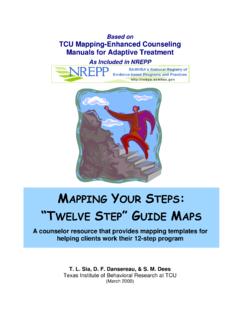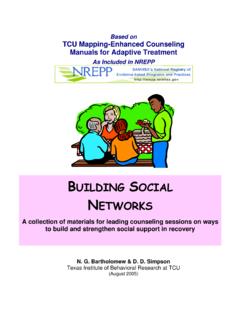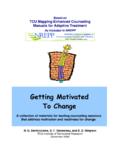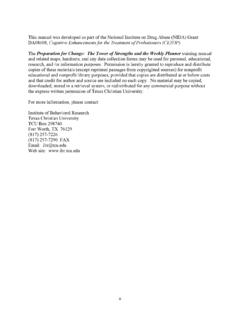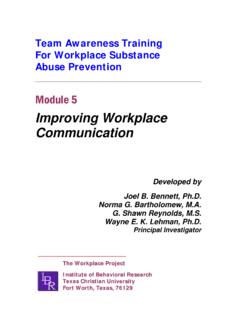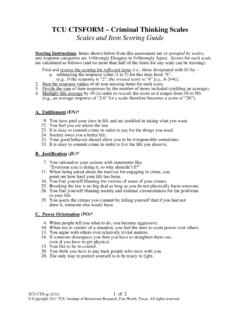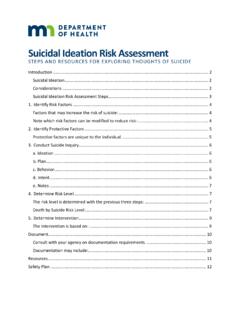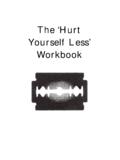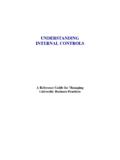Transcription of Understanding and Reducing Angry Feelings
1 Based on TCU Mapping-Enhanced Counseling Manuals for Adaptive Treatment As Included in NREPP. Understanding AND Reducing . Angry Feelings . A collection of materials for leading counseling sessions that encourage new ways of thinking about and responding to anger N. G. Bartholomew & D. D. Simpson Texas Institute of Behavioral Research at TCU. (August 2005). TCU Mapping-Enhanced Counseling manuals provide evidence-based guides for adaptive treatment services (included in National Registry of Evidence-based Programs and Practices, NREPP, 2008). They are derived from cognitive-behavioral models designed particularly for counselors and group facilitators working in substance abuse treatment programs. Although best suited for group work, the concepts and exercises can be directly adapted to individual settings. When accompanied by user-friendly information about client assessments that measure risks , needs, and progress over time, TCU Mapping- Enhanced Counseling manuals represent focused, time-limited strategies for engaging clients in discussions and activities on important recovery topics.
2 These materials and related scientific reports are available as Adobe PDF files for free download at _____. Copyright 2005 Texas Institute of Behavioral Research at TCU, Fort Worth, Texas 76129. All rights reserved. Permission is hereby granted to reproduce and distribute copies of this manual (except reprinted passages from copyrighted sources) for nonprofit educational and nonprofit library purposes, provided that copies are distributed at or below costs and that credit for authors, source, and copyright are included on each copy. No material may be copied, downloaded, stored in a retrieval system, or redistributed for any commercial purpose without the expressed written permission of Texas Christian University. Texas Institute of Behavioral Research ii TCU ( 2005). TCU MAPPING-ENHANCED COUNSELING MANUALS. FOR ADAPTIVE TREATMENT. Understanding AND Reducing Angry Feelings . Table of Contents Part 1. Understanding 1. Description: Discussion activity for group with worksheets and handout Source: Adapted in part from Neurobehavioral Treatment (UCLA /NDRI).
3 Contact: UCLA/Matrix Institute at Part 2. Managing Anger in Relationships .. 10. Description: Leader guide for group with topic notes, worksheets, handouts, and discussion questions Source: TCU / Institute of Behavioral Research. From treatment manual Straight Ahead: Transition Skills for Recovery Contact: IBR at Part 3. Mapping Worksheets .. 20. Description: A set of activity worksheets for use in group discussions or individual counseling Source: TCU / Institute of Behavioral Research. From treatment manual TCU. Guide Maps: A Resource for Counselors Contact: IBR at Part 4. The Aggression Cycle .. 33. Description: Worksheets for clients in group or individual counseling Source: Adapted from CSAT workbook Anger Management for Substance Abuse Clients Links of Interest .. 39. Description: Links to Web sites featuring materials on Anger Copyright 2004; 2005 TCU Institute of Behavioral Research, Fort Worth, Texas. All rights reserved. Texas Institute of Behavioral Research iii TCU ( 2005).
4 Part 1: Understanding Anger Understanding Anger is adapted in part from a core set of materials developed by Matrix, Inc. (at UCLA) and NDRI for relapse prevention group work. This session includes worksheets, handouts, and group leader instruction for facilitating a session on the antecedents of anger to help participants become more aware of their physical cues and emotional responses to anger and frustration. Group leader discussion questions are provided to help encourage clients to talk about the situational aspects of anger and strategies for self-regulation. Source: Neurobehavioral Treatment (UCLA Matrix Institute/NDRI). Texas Institute of Behavioral Research 1 TCU ( 2005). Understanding Anger Step 1. Introduce the session by underscoring that it is helpful to understand anger in order to deal with it. A common question we all have is Why do I get Angry in the first place? The simplest answer is: We get Angry because we are human beings. Anger is a normal human emotion.
5 Human anger is more complex than the anger we see other animals expressing. For example, Rover, the dog, may become Angry when you pull his tail, and he may growl or bite because he feels threatened or annoyed. However, Rover will probably never get mad at himself for napping when he should have been guarding the yard. People are different. We get Angry because of events, experiences, and also because of our thoughts, Feelings , attitudes, and, sometimes, our own behavior. Sketch a tree diagram, labeled as shown below, on flip chart paper or erasable board, and discuss with participants: Anger Fear or Pain Anger is often conceptualized as arising from either fear or pain. The ideas of fear . and pain are defined very broadly. Fear includes not just fear of something physical, but also psychological fear. For example, fear of losing face, fear of loss of esteem or regard, fear of being laughed at or appearing ridiculous, fear of being abandoned. Pain is the same.
6 It's more than just pain from being physically hurt. It includes emotional and psychological pain feeling pain from someone's words or actions, the pain of loss of love or regard, feeling pain because of life's unfairness. Texas Institute of Behavioral Research 2 TCU ( 2005). Understanding Anger So my anger at being called a rude name may have its roots in my fear of losing face or from my pain over someone's unkindness, or from a combination of these things. So when someone suddenly pulls in front of me on the expressway, my initial fear that I might crash into the back of their car quickly turns to anger over their bad driving. Briefly discuss this roots and tree concept of anger. Use some of the following questions: When was the last time you felt Angry or had an Angry outburst that was probably related to fear of losing face or looking weak? When was the last time you felt Angry or had an Angry outburst that was probably related to pain being hurt by someone's words or actions?
7 What do you see as helpful in thinking about anger in terms of roots and tree with pain and fear? Summarize discussion with the following: First Key to a Better Understanding of Anger: Ask yourself: What am I afraid of? What is causing me pain? Is it a combination of factors? These questions are tough! It is difficult to think about our Feelings and behavior, then take it to a deeper level. And most of us don't like to dwell on our deeply felt fears and hurts. However, many people find that making the effort to identify the root of the anger helps them to deal with it more successfully. It also helps people better understand their anger hot buttons or triggers, allowing them to have more control in difficult situations. Step 2. Distribute Recognizing Anger Triggers worksheets (page 8), and introduce this activity with some of the following points: To better understand anger, it's helpful to consider the kinds of things that we all have experienced that may influence feeling Angry and the degree of anger we may feel.
8 These include: Texas Institute of Behavioral Research 3 TCU ( 2005). Understanding Anger Surroundings or environment: The physical location or situation we find ourselves in can influence Angry Feelings . Sometimes we don't pay attention to the things in the background or the environment that annoy us or create frustration, setting the stage for anger to erupt more easily. For example: Are you being bumped around in a crowded area? Is the temperature uncomfortable? Are you stuck in a long line or in traffic? Do you live with racial or political oppression? Are you experiencing economic hardships? Are you treated unfairly because of race, religion, sexual orientation, or other prejudice? Personal health: We have all had the experience of being more short-tempered when we are not feeling well or when we have a headache. Again, we often fail to pay attention to physical health issues that can trigger Angry reactions. For example: Are you tired? Fatigued? Experiencing pain or a chronic, painful condition?
9 Do you sleep well? Eat a balanced diet and get enough exercise? Do you experience a lot of anxiety, stress or tension? Are your depressed? Is your outlook on life positive or negative? Is your self-esteem high or low? These factors can contribute to Angry responses from time to time. Attitudes and expectations: This is probably the biggest factor in fueling anger and keeping it going. We create much of our own anger when we think in ways that clash with the real world. In other words, when we expect things to always be predictable, just, fair, honest, or kind in a real world that is frequently unpredictable, unjust, unfair, uncontrollable, and harsh, then we set ourselves up for frustration. For example: Are you rigid and inflexible in your beliefs and expectations? Do you insist the world should abide by rules of fairness, justice, and doing things right? . Do you expect all your accomplishments should be recognized and rewarded? Do you expect you should always win or have things your way?
10 These beliefs, attitudes, and expectations are human, but unfortunately, they are also unrealistic. Ask participants to complete their worksheets, keeping in mind the kinds of things that most frequently trigger Angry reactions. Invite participants to share some of their answers with the group. Process the activity with some of the following questions: When you think about it, what might be at the root of the anger situation you discussed about your family? What is an example of allowing your own attitudes and expectations to fuel your anger? What attitudes or expectations seem to fuel your anger the most? Is anger caused by Feelings different from anger caused by a situation? In what ways? Texas Institute of Behavioral Research 4 TCU ( 2005). Understanding Anger Summarize discussion with the following: Second Key to a Better Understanding of Anger: Learn to recognize your own anger triggers and high risk for anger situations. Advanced warning can be a good thing.


